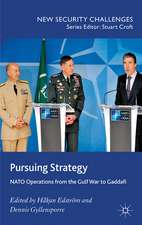Korea at the Center: Dynamics of Regionalism in Northeast Asia: Dynamics of Regionalism in Northeast Asia
Autor Charles K. Armstrong, Gilbert Rozman, Samuel S. Kim, Stephen Kotkinen Limba Engleză Hardback – 15 mar 2006
| Toate formatele și edițiile | Preț | Express |
|---|---|---|
| Paperback (1) | 370.71 lei 6-8 săpt. | |
| Taylor & Francis – 15 mai 2005 | 370.71 lei 6-8 săpt. | |
| Hardback (1) | 1000.27 lei 6-8 săpt. | |
| Taylor & Francis – 15 mar 2006 | 1000.27 lei 6-8 săpt. |
Preț: 1000.27 lei
Preț vechi: 1219.84 lei
-18% Nou
Puncte Express: 1500
Preț estimativ în valută:
191.40€ • 200.34$ • 159.31£
191.40€ • 200.34$ • 159.31£
Carte tipărită la comandă
Livrare economică 31 martie-14 aprilie
Preluare comenzi: 021 569.72.76
Specificații
ISBN-13: 9780765616555
ISBN-10: 0765616556
Pagini: 344
Dimensiuni: 152 x 229 x 27 mm
Greutate: 0.45 kg
Ediția:1
Editura: Taylor & Francis
Colecția Routledge
Locul publicării:Oxford, United Kingdom
ISBN-10: 0765616556
Pagini: 344
Dimensiuni: 152 x 229 x 27 mm
Greutate: 0.45 kg
Ediția:1
Editura: Taylor & Francis
Colecția Routledge
Locul publicării:Oxford, United Kingdom
Notă biografică
Charles K. Armstrong, Gilbert Rozman, Samuel S. Kim, Stephen Kotkin
Cuprins
Preface and Acknowledgments, Stephen Kotkin; Introduction, Gilbert Rozman; Part I. Competing Visions of Regional Order: Late Nineteenth/Early Twentieth Centuries; 1. Korea in Japanese Visions of Regional Order, Takashi Inoguchi; 2. Russian Views of Korea, China, and the Regional Order in Northeast Asia, Alexander Lukin; 3. Civilization, Race, or Nation? Korean Visions of Regional Order in the Late Nineteenth Century, Hahm Chaibong; 4. Trade, Dependency, and Colonialism: Foreign Trade and Korea's Regional Integration, 1876-1910, Kirk W. Larsen; Part II. Competing Regional Orders: Colonialism, the Cold War, and Their Legacies; 5. From Japanese Imperium to American Hegemony: Korean-Centrism and the Transformation of the International System, Bruce Cumings; 6. Japanese Colonial Infrastructure in Northeast Asia: Realities, Fantasies, Legacies, Daqing Yang; 7. A Socialist Regional Order in Northeast Asia After World War II, Stephen Kotkin and Charles K. Armstrong; 8. Japan's Asian Regionalism and South Korea, Chung-in Moon and Seung-won Suh; Part III. Toward a Broad Regionalism?; 9. Regionalism Northeast Asia: Korea's Return to Center Stage, Gilbert Rozman; 10. Inter-Korean Relations in Northeast Asian Geopolitics, Samuel S. Kim; 11. Japan's Multilevel Approach Toward the Korean Peninsula After the Cold War, Tsuneo Akaha; 12. Korea and China in Northeast Asia: From Stable Bifurcation to Complicated Interdependence, Jae Ho Chung; 13. Korea in Russia's Post-Cold War Regional Political Context, Evgeny P. Bazhanov; 14. Environmental Regime-Building in Northeast Asia: Korea's Pursuit of Leadership, Shin-wha Lee; 15. The Korean Wave: Transnational Cultural Flows in Northeast Asia, Jung-Sun Park; Epilogue: Korea, Northeast Asia, and the Long Twentieth Century, Charles K. Armstrong; Notes; * About the Editors and Contributors; * Index.
Descriere
Illuminating the role of the Korean peninsula in three modern historical periods, this volume offers a fresh appraisal of Korea as the key to the coalescence of a broad, open Northeast Asian regionalism in the twenty-fifth century.























